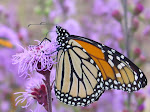This year seems different. Garden trends this year are ushering in a new age of eco-friendly landscape products and services. These lists indicates that new and experienced gardeners are looking for ways to be more earth-friendly.
Here are some of the trends that pertain directly to urban native landscaping:
1. Wild Edibles at home
Popular native shrubs like low bush Blueberry, Raspberry, Elderberry, Juneberry, wild Plum and American Hazelnut offer edible fruit for people and wildlife in the back yard. Wild strawberries, Fragrant Hyssop, Wild Bergamot, and Purple Coneflower (Echinacea) lead the way with edible wildflowers.
2. Vegetable Gardens
People are growing more vegetables and herbs in their yards because they know if they are "organically grown" by avoiding harmful chemicals. Gardeners are using native wildflowers to attract bees to their vegetable gardens. Integration of cultivated and native plants is becoming more common place.
3. Natural Weed and Pest control
Gardeners are using products like Phydura (a vinegar, soybean oil, clove oil mix) as an alternative herbicide. Soapy water is sprayed on plants to fend off aphids. These methods take a little longer but are less problematic. Some gardeners are carefully selecting certain native wildflowers to attract insect predators to their gardens to control insect pests.
4. Building the Soil
Gardeners are using more compost made of yard waste and leaves to feed plants and microorganisms that live in the soil. Natural, non-dyed wood mulches reduce weeds and natural compost to feed plants. People are using leaves (also known as "brown gold") as a mulch.
5. Water-wise
Gardeners are using more drought tolerant plants, prairie plants as garden plants to reduce the demand for watering gardens. Rain harvesting (often rain barrells) are used to water non-edible plants in gardens. Rain gardens are used for reducing water run-off from properties. Rain gardens help reduce sediment and organics from entering our local lakes and streams via storm sewers. Ornamental water features and fountains are getting smaller to conserve water. These small water features are purposefully used to attract birds with the sound of babbling water.
6. Light
Gardeners like to use landscape lighting to highlight their landscape but they are doing it with solar lights and are avoiding up-lighting for outdoor paths and gathering spaces. Down-lights reduce light pollution for migrating birds.
7. Community Gardening
Gardeners who don't own property often garden in shared wildflower gardens by maintaining them by weekly or monthly group efforts. These gardens are often located in local parks in the neighborhood. Invasive plant species removal projects in city parks are often performed by volunteer gardeners, and residents in the local areas which benefit the greater society and wildlife. Community gardens for vegetable gardeners are in growing demand.
8. Buying Local
Native plant growers are often located at the just outside of the city. They often use seeds and cutting sources within 100 miles or closer to where they are grown. Gardeners who use native plants prefer to use "local genotypes" because they are more likely to survive fluctuations in the climate.
9. Gardening for Relationships
Native plant gardeners are carefully selecting plants to deliberately attract birds and beneficial insects to their yards. The Wild Ones (a non-profit organization), Audubon Society and various university websites are sharing information about native plants and how they attract birds, butterflies and bees.


No comments:
Post a Comment